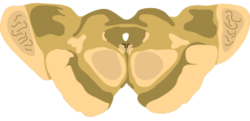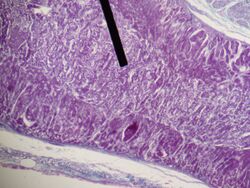Medicine:Cell-based therapies for Parkinson's disease

Cell-based therapies for Parkinson's disease include various investigational procedures which transplant specific populations of cells into the brains of people with Parkinson's disease. The investigation of cell transplantation therapies followed the discovery that the death of dopaminergic neurons in the substantia nigra pars compacta resulted in the motor symptoms of the disease. Thus, cell transplantation has focused on various dopamine producing cells throughout the body.[1][2]
List of cell-based sources
- fetal ventral mesencephalic tissue (human and porcine)
- human dopamine progenitor cells derived from autologous induced pluripotent stem cells (iPSCs)
- adrenal medulla
- sympathetic ganglia
- carotid body
- retinal pigment epithelium
- embryonic stem cells
- induced pluripotent stem cells
- mesenchymal stem cells
Fetal ventral mesencephalic tissue
Human
Porcine
Adrenal medulla
The first cell-based therapy investigated for Parkinson's disease utilized the adrenal medulla. The adrenal medulla is the innermost part of the adrenal gland and contains neural crest derived chromaffin cells which secrete norepinephrine, epinephrine and to a far lesser extent dopamine into the blood. Autotransplantation of adrenal medullary tissue into the brains of animal models of Parkinson's disease showed minimal benefits.[3][4] Despite this, open-label trials were undergone in humans which showed only modest benefits.[5][6] Following these initial disappointing results however, a trial in Mexico demonstrated significant motor benefits in two patients with Parkinson's disease who had undergone the procedure.[7] This publication incited widespread interest in the field and over the next few years hundreds of patients received adrenal medulla transplants.[1] It was only when a registry was set up to consolidate all the data was it revealed that most patients did not benefit from the procedure to any significant extent.[8][9] Furthermore, postoperative complications such as psychiatric disturbances were realized. These combined findings eventually led to the abandonment of this transplant procedure, which was largely flawed from the start.[2]
Sympathetic ganglia
Carotid body
The carotid body is a group of chemoreceptor cells located at the bifurcation of the common carotid artery. It includes two populations of cells; glomus (type I) cells and sustentacular (type II) cells. Glomus cells are derived from the neural crest and secrete dopamine in response to hypoxemia (low level of oxygen in the blood).[10] Based on their ability to secrete dopamine and also glial cell-derived neurotrophic factor (GDNF),[11] these cells have been investigated as an intrastriatal autograft therapy for patients with Parkinson's disease.[12][13] A clinical trial exploring this initially demonstrated motor benefits, unfortunately these benefits disappeared after 6–12 months, in correlation with poor survival of the grafted cells.[14]
Retinal pigment epithelium
The retinal pigment epithelium (RPE) is a single layer of melanin containing cells located between the neural retina and the choroid. Retinal pigment epithelial cells synthesize dopamine and secrete the neurotrophic factors glial-cell derived neurotrophic factor (GDNF) and brain-derived neurotrophic factor (BDNF).[15] Initial trials of intrastriatal allografts of cultured human retinal pigment epithelial cells attached to microcarriers (Spheramine, Bayer Schering Pharma AG) demonstrated
Stem cells
Researchers have differentiated ESCs into dopamine-producing cells with the hope that these neurons could be used in the treatment of Parkinson's disease.
References
- ↑ 1.0 1.1 Jankovic, Joseph; Tolosa, Eduardo (2015). "49". Parkinson's Disease and Movement Disorders (6th ed.). Philadelphia: Wolters Kluwer. pp. 518–525. ISBN 9781496317636. OCLC 953863020.
- ↑ 2.0 2.1 Barker, Roger A.; Drouin-Ouellet, Janelle; Parmar, Malin (September 2015). "Cell-based therapies for Parkinson disease—past insights and future potential" (in en). Nature Reviews Neurology 11 (9): 492–503. doi:10.1038/nrneurol.2015.123. ISSN 1759-4758. PMID 26240036.
- ↑ Freed, W. J.; Morihisa, J. M.; Spoor, E.; Hoffer, B. J.; Olson, L.; Seiger, A.; Wyatt, R. J. (1981-07-23). "Transplanted adrenal chromaffin cells in rat brain reduce lesion-induced rotational behaviour". Nature 292 (5821): 351–352. doi:10.1038/292351a0. ISSN 0028-0836. PMID 7254334. Bibcode: 1981Natur.292..351F.
- ↑ Morihisa, John M.; Nakamura, Richard K.; Freed, William J.; Mishkin, Mortimer; Wyatt, Richard J. (1987). "Transplantation Techniques and the Survival of Adrenal Medulla Autografts in the Primate Brain" (in en). Annals of the New York Academy of Sciences 495 (1): 599–604. doi:10.1111/j.1749-6632.1987.tb23703.x. ISSN 1749-6632. PMID 3111329. Bibcode: 1987NYASA.495..599M.
- ↑ Lindvall, O.; Backlund, E. O.; Farde, L.; Sedvall, G.; Freedman, R.; Hoffer, B.; Nobin, A.; Seiger, A. et al. (Oct 1987). "Transplantation in Parkinson's disease: two cases of adrenal medullary grafts to the putamen". Annals of Neurology 22 (4): 457–468. doi:10.1002/ana.410220403. ISSN 0364-5134. PMID 3435067.
- ↑ Backlund, E. O.; Granberg, P. O.; Hamberger, B.; Knutsson, E.; Mårtensson, A.; Sedvall, G.; Seiger, A.; Olson, L. (Feb 1985). "Transplantation of adrenal medullary tissue to striatum in parkinsonism. First clinical trials". Journal of Neurosurgery 62 (2): 169–173. doi:10.3171/jns.1985.62.2.0169. ISSN 0022-3085. PMID 2578558.
- ↑ Madrazo, Ignacio; Drucker-Colín, René; Díaz, Víctor; Martínez-Mata, Juan; Torres, César; Becerril, Juan José (1987-04-02). "Open Microsurgical Autograft of Adrenal Medulla to the Right Caudate Nucleus in Two Patients with Intractable Parkinson's Disease". New England Journal of Medicine 316 (14): 831–834. doi:10.1056/NEJM198704023161402. ISSN 0028-4793. PMID 3821826.
- ↑ Freed, W. J.; Poltorak, M.; Becker, J. B. (Nov 1990). "Intracerebral adrenal medulla grafts: a review". Experimental Neurology 110 (2): 139–166. doi:10.1016/0014-4886(90)90026-O. ISSN 0014-4886. PMID 1977606. https://deepblue.lib.umich.edu/bitstream/2027.42/28322/1/0000078.pdf.
- ↑ Goetz, C. G.; Stebbins, G. T.; Klawans, H. L.; Koller, W. C.; Grossman, R. G.; Bakay, R. A.; Penn, R. D. (Nov 1991). "United Parkinson Foundation Neurotransplantation Registry on adrenal medullary transplants: presurgical, and 1- and 2-year follow-up". Neurology 41 (11): 1719–1722. doi:10.1212/WNL.41.11.1719. ISSN 0028-3878. PMID 1944898.
- ↑ Iturriaga, R.; Alcayaga, J.; Gonzalez, C. (2009), Gonzalez, Constancio; Nurse, Colin A.; Peers, Chris, eds., "Neurotransmitters in Carotid Body Function: The Case of Dopamine – Invited Article", Arterial Chemoreceptors, Advances in Experimental Medicine and Biology (Springer Netherlands) 648: pp. 137–143, doi:10.1007/978-90-481-2259-2_16, ISBN 9789048122585, PMID 19536475
- ↑ Villadiego, Javier; Méndez-Ferrer, Simón; Valdés-Sánchez, Teresa; Silos-Santiago, Inmaculada; Fariñas, Isabel; López-Barneo, José; Toledo-Aral, Juan J. (2005-04-20). "Selective glial cell line-derived neurotrophic factor production in adult dopaminergic carotid body cells in situ and after intrastriatal transplantation". The Journal of Neuroscience 25 (16): 4091–4098. doi:10.1523/JNEUROSCI.4312-04.2005. ISSN 1529-2401. PMID 15843611. PMC 6724965. https://idus.us.es/xmlui/bitstream/11441/17781/1/Selective%20glial%20cel%20line-derived%20neurotrophic%20factor%20production%20in%20adult%20dopaminergic%20carotid%20body%20cells%20in%20situ%20and%20after%20intrastriatal%20transplantation.pdf.
- ↑ Arjona, Ventura; Mínguez-Castellanos, Adolfo; Montoro, Rafael J.; Ortega, Angel; Escamilla, Francisco; Toledo-Aral, Juan José; Pardal, Ricardo; Méndez-Ferrer, Simón et al. (August 2003). "Autotransplantation of human carotid body cell aggregates for treatment of Parkinson's disease". Neurosurgery 53 (2): 321–328; discussion 328–330. doi:10.1227/01.NEU.0000073315.88827.72. ISSN 0148-396X. PMID 12925247.
- ↑ Espejo, Emilio F; Montoro, Rafael J; Armengol, José A; López-Barneo, José (February 1998). "Cellular and Functional Recovery of Parkinsonian Rats after Intrastriatal Transplantation of Carotid Body Cell Aggregates" (in en). Neuron 20 (2): 197–206. doi:10.1016/S0896-6273(00)80449-3. PMID 9491982.
- ↑ Mínguez‐Castellanos, Adolfo; Escamilla‐Sevilla, Francisco; Hotton, Gary R; Toledo‐Aral, Juan J; Ortega‐Moreno, Ángel; Méndez‐Ferrer, Simón; Martín‐Linares, José M; Katati, Majed J et al. (August 2007). "Carotid body autotransplantation in Parkinson disease: a clinical and positron emission tomography study". Journal of Neurology, Neurosurgery, and Psychiatry 78 (8): 825–831. doi:10.1136/jnnp.2006.106021. ISSN 0022-3050. PMID 17220289.
- ↑ Ming, Ming; Li, Xuping; Fan, Xiaolan; Yang, Dehua; Li, Liang; Chen, Sheng; Gu, Qing; Le, Weidong (2009-06-28). "Retinal pigment epithelial cells secrete neurotrophic factors and synthesize dopamine: possible contribution to therapeutic effects of RPE cell transplantation in Parkinson's disease". Journal of Translational Medicine 7: 53. doi:10.1186/1479-5876-7-53. ISSN 1479-5876. PMID 19558709.
 |



